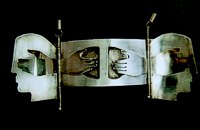Ágnes Schramm, Ľuba Belohradská
The author has been devoted to creating artistic jewels as a sculptor since 1960s, a fact which also made her a founder of this field in Slovak art. Erna Masarovičová (1926) after studying textiles at the University of Artistic Industry in Budapest (1943 – 1944) and ceramics at the Higher Art and Industrial School in Bratislava (1946 – 1951) continued her artistic education at the University of Fine Arts in Bratislava. Between 1951 and 1956 she frequented the sculpting studio of Fraňo Štefunko. Erna Masarovičová is one of those rare Slovak sculptors that was devoted to creating chamber sculpture in the 1960s. Her works were created by techniques such as cast tin, welded steel and copper. In addition, copper has been also a material from which she created her first jewels, not only in her creation but also in the history of contemporary Slovak art as a whole. In 1961 she created her first pieces of large copper pendants on a circle. Brooches and pendants from 1963 to 1965 are composed more plastically, spatially and, by placing a stone, also more colourfully. Pendants with stone or bell-shaped pendants are distantly reminiscent of Great Moravian jewels. Curtains with a figural motif of a female stature are slightly associative with the paintings of Marco Chagallo. She still uses copper but in combination with silver.
The typology of jewels (brooch, large and small pendant) was enriched by a bracelet; from the first creations from copper through thin silver rings and light bracelets up to heavier, more -demanding bracelets.
In her jewels from 1970s she returned to her motifs and technologies from previous years. However, she now enriched them in a phenomenon which made was unique in Slovak jewel history. As a sculptor she clearly realized the fact that she would not be able to overcome the barrier that lies in the technical and craft preparedness of her colleagues – jewellery makers, and therefore she found a solution. She makes jewels from silver sheet as topically as well as in artistic form similar to her chamber creations. A new element is a use of old silver objects (pocket watch, cutlery) for creating jewels. Spoons and forks – their scooping parts as well as holding parts get a new function by being twisted, tinkered, embossed, cut and soldered. She remains unique with these small works of art in Slovak jewellery. Since the 1980s she has broadened her repertoire with pins and amulets. They usually show stylized female and male faces cast with rich ornament such as hair with kind profiles together made into a sculpture. Even the latest work from this author shows her distinctive handwriting, which is based mainly in the detail on every jewel.
